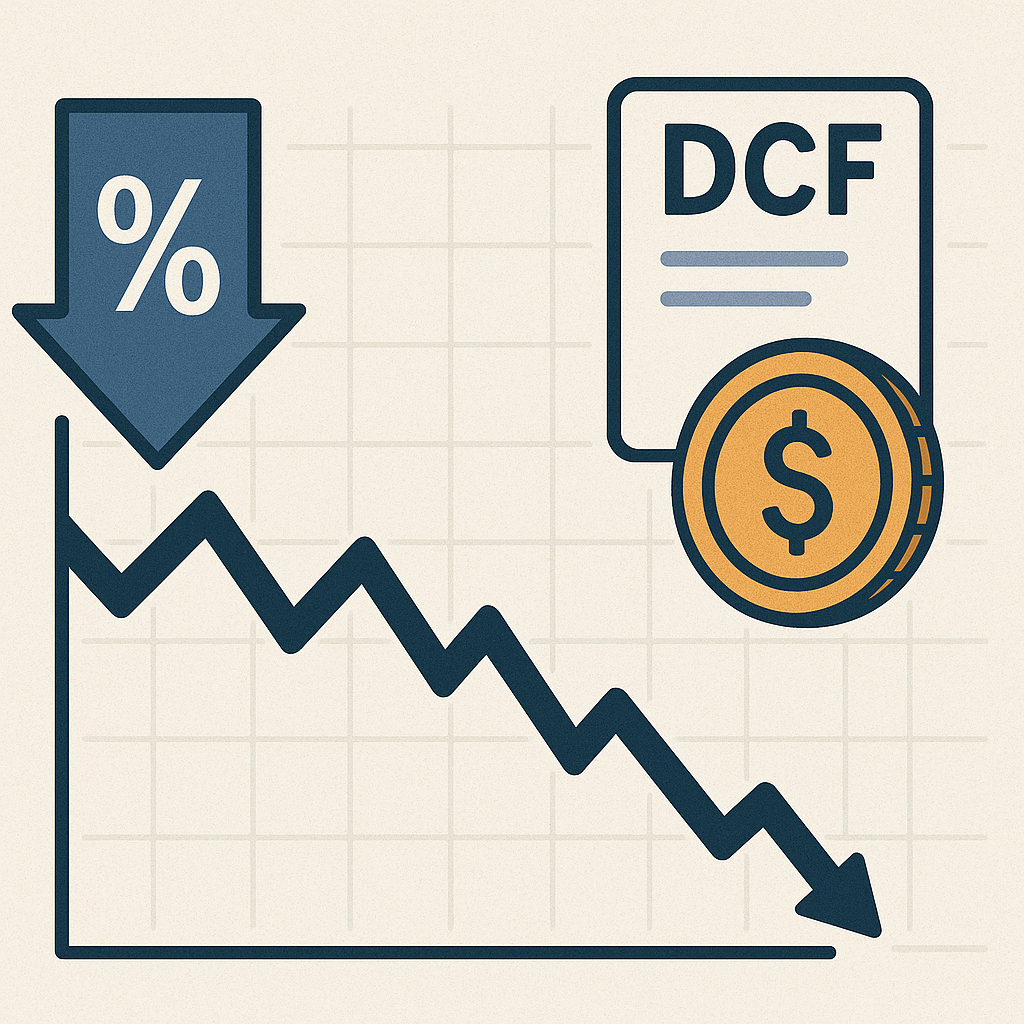The financial markets are a complex ecosystem, constantly influenced by a myriad of interconnected factors, both microeconomic and macroeconomic. Among these, interest rates stand out as a fundamental economic lever, wielded by central banks to influence the broader economy. Their subtle, yet profound, shifts reverberate throughout various asset classes, with a particularly significant impact on the valuation of stocks. For modern investors navigating this dynamic landscape, a clear understanding of how interest rate movements translate into changes in stock valuations is not merely academic; it is crucial for making informed decisions, optimizing portfolio strategies, and interpreting market signals.
This essay aims to demystify the intricate relationship between interest rate dynamics and equity valuations. We will embark on a journey to explain the core concepts of interest rates and their macroeconomic significance. Subsequently, we will unpack key stock valuation methodologies, including the widely used Discounted Cash Flow (DCF) analysis and the foundational Price-to-Earnings (P/E) ratio, breaking them down into beginner-friendly terms. The core of our exploration will then focus on the precise mechanisms through which fluctuations in interest rates permeate these valuation models, affecting everything from corporate borrowing costs to investor sentiment and the relative attractiveness of different types of stocks, such as growth versus value companies. By the end of this guide, even those new to financial analysis will possess a clearer picture of this vital economic interplay, empowering them to better understand how monetary policy shapes the investment landscape.
The Basics of Interest Rates: A Fundamental Economic Force
At the heart of any financial system lies the concept of interest rates. Far from being an abstract economic term, interest rates represent the cost of borrowing money or, conversely, the return earned on lending money. They are a powerful tool used by central banks to manage economic activity, influencing everything from the cost of your mortgage to a company’s decision to expand.
What Are Interest Rates and How Are They Set?
In simple terms, an interest rate is the percentage charged by a lender to a borrower for the use of assets. It is typically expressed as an annual percentage of the principal amount. When you take out a loan, the interest rate is the fee you pay. When you deposit money in a savings account, the interest rate is the compensation you receive.
The primary mechanism for setting and influencing interest rates in the United States is through the Federal Reserve (the “Fed”), which serves as the country’s central bank. The Federal Reserve conducts monetary policy to achieve its dual mandate: maximizing employment and maintaining stable prices (controlling inflation). While the Fed doesn’t directly set all interest rates, it significantly influences them through a key policy rate:
- The Federal Funds Rate: This is the target interest rate set by the Federal Open Market Committee (FOMC) of the Federal Reserve. It’s the rate at which commercial banks lend their excess reserves to other banks overnight. While it’s an overnight lending rate between banks, changes in the federal funds rate cascade throughout the entire financial system.
- When the Fed raises the federal funds rate, it becomes more expensive for banks to borrow money. This cost is then passed on to consumers and businesses in the form of higher rates on loans (mortgages, car loans, credit cards) and higher yields on savings accounts and bonds.
- When the Fed lowers the federal funds rate, borrowing becomes cheaper, encouraging spending and investment to stimulate economic activity.
Beyond the federal funds rate, other influential rates include:
- Prime Rate: This is the interest rate that commercial banks charge their most creditworthy corporate customers. It typically moves in tandem with the federal funds rate.
- Mortgage Rates: These are the interest rates on home loans, directly impacting the housing market and consumer spending.
- Bond Yields: The return an investor receives on a bond. Treasury yields (on U.S. government bonds) are particularly important as they are considered “risk-free” rates and serve as benchmarks for other interest rates in the economy. Changes in Treasury yields reflect market expectations about future interest rates and inflation.
Why Do Interest Rates Matter? Their Far-Reaching Influence
The impact of interest rates extends far beyond just borrowing and lending. They are a powerful determinant of economic activity and investor behavior:
- Influence on Borrowing and Spending: Higher interest rates make it more expensive for consumers to borrow money for big purchases like homes and cars, dampening consumer demand. Similarly, businesses face higher costs for loans to finance expansion, equipment, or inventory, which can curb investment.
- Impact on Saving and Investment: When interest rates rise, saving becomes more attractive as depositors earn a higher return on their money. This can encourage individuals to save rather than spend. From an investment perspective, higher bond yields make fixed-income investments more appealing relative to riskier assets like stocks.
- Inflation Control: By making borrowing more expensive and encouraging saving, higher interest rates reduce the amount of money circulating in the economy. This dampens demand, which helps to cool down inflationary pressures (i.e., slows the rate at which prices are rising).
- Economic Growth: Lower interest rates stimulate economic activity by making borrowing cheaper, encouraging consumer spending and business investment, thereby boosting economic growth. Conversely, higher rates can slow down an overheating economy to prevent excessive inflation.
Understanding central bank policy rates, macroeconomic factors affecting interest rates, and the broad impact of interest rates on borrowing costs are fundamental to grasping their influence on the financial markets. For more on how the Federal Reserve operates, the Federal Reserve’s official website offers comprehensive information: https://www.federalreserve.gov/.
Unpacking Stock Valuations: Determining an Asset’s Worth
Before we can appreciate how interest rates sway stock prices, we must first understand how stocks are valued. Stock valuation is the process of estimating the intrinsic, or true, economic value of a company’s stock. It’s about determining what a company is truly worth, as opposed to its current market price, which can fluctuate due to supply and demand, sentiment, and short-term news.
H2: Why is Stock Valuation Important?
For investors, understanding stock valuation is crucial for several reasons:
- Avoiding Overpaying: Valuation helps you determine if a stock’s current market price is reasonable, expensive, or cheap relative to its underlying value. Buying an overvalued stock increases the risk of capital loss.
- Identifying Opportunities: By valuing companies, investors can identify undervalued stocks that the market might be overlooking, offering potential for future capital appreciation.
- Informed Decision-Making: Valuation provides a framework for making rational investment decisions, moving beyond speculation and emotions.
While there are numerous approaches to valuing a company’s stock, two key methods are fundamental for beginners to grasp: Discounted Cash Flow (DCF) analysis and the Price-to-Earnings (P/E) ratio. These are key equity valuation techniques used in fundamental analysis.
Key Stock Valuation Methods for Beginners
1. Discounted Cash Flow (DCF) Analysis: The Present Value of Future Cash Flows
At its core, the Discounted Cash Flow (DCF) analysis is based on the principle that the value of any asset is the present value of its future cash flows. For a company, this means its intrinsic value is equal to the sum of all its projected future free cash flows, discounted back to today’s value.
- Concept: Imagine a company that you expect to generate a certain amount of cash profit each year for the foreseeable future. A dollar earned five years from now is worth less than a dollar earned today due to inflation, the opportunity cost of investing that money elsewhere, and the inherent risk. DCF accounts for this by “discounting” those future cash flows.
- How it Works:
- Project Future Free Cash Flows: The first step involves forecasting the company’s Free Cash Flow (FCF) for a specific period, typically 5 to 10 years. FCF is the cash a company generates after accounting for cash outflows to support its operations and maintain its capital assets. This requires assumptions about revenue growth, operating margins, capital expenditures, and working capital changes.
- Estimate Terminal Value: Beyond the explicit forecast period, a “terminal value” is estimated. This represents the present value of all cash flows the company is expected to generate after the explicit forecast period, assuming a perpetual growth rate.
- Determine the Discount Rate: This is arguably the most crucial component and where interest rates play a direct role. The discount rate represents the required rate of return an investor expects to earn for taking on the risk of investing in the company. For DCF, the most common discount rate used is the Weighted Average Cost of Capital (WACC). WACC reflects the average rate of return a company expects to pay to all its security holders (both debt and equity) to finance its assets.
- Discount Future Cash Flows: Each projected future cash flow (including the terminal value) is then discounted back to its present value using the discount rate. The sum of these present values gives you the estimated intrinsic value of the company. Dividing this by the number of outstanding shares yields the intrinsic value per share.
The formula for present value is: PV=CF/(1+r)n Where:
- PV = Present Value
- CF = Cash Flow in a given period
- r = Discount Rate
- n = Number of periods in the future
Understanding the discount rate in DCF is key to understanding how macroeconomic factors affect intrinsic value.
2. Price-to-Earnings (P/E) Ratio: A Simple Comparison Tool
The Price-to-Earnings (P/E) ratio is one of the most widely used valuation multiples, particularly popular among beginners due to its simplicity.
- Concept: The P/E ratio measures how much investors are willing to pay for each dollar of a company’s earnings. It provides a quick snapshot of how expensive or cheap a stock might be relative to its profitability.
- How it Works: The P/E ratio is calculated by dividing a company’s current stock price by its earnings per share (EPS) over a specific period (typically the last 12 months, or a forward-looking estimate for the next 12 months).
- P/E=Market Value Per Share/Earnings Per Share (EPS)
- P/E=Market Value Per Share/Earnings Per Share (EPS)
- Interpretation:
- A higher P/E ratio generally suggests that investors expect higher future growth from the company or are willing to pay a premium for its earnings.
- A lower P/E ratio might suggest that the company is undervalued, has lower growth expectations, or is facing challenges.
- Limitations: While simple, the P/E ratio has limitations. It doesn’t account for a company’s debt, its growth prospects (a high P/E might be justified by high growth), or differences in accounting practices between companies. Therefore, it’s best used for comparing companies within the same industry or against the company’s historical P/E range.
Other common multiples include Price-to-Sales (P/S) and Price-to-Book (P/B), which are also used to interpret equity valuations and conduct fundamental analysis for stock valuation. For more on various stock valuation methods, Investopedia provides a comprehensive guide: https://www.investopedia.com/articles/fundamental/85/valuing-a-stock.asp.
The Intricate Dance: How Interest Rates Influence Stock Valuations
The relationship between interest rates and stock valuations is fundamental to understanding market dynamics. Interest rate changes, primarily driven by central bank monetary policy, act as a powerful current that can uplift or depress the perceived value of equities through several interconnected channels. Modern investors must grasp these mechanisms to properly interpret market movements and make informed decisions about their long-term investment strategies.
1. Direct Impact on Discounted Cash Flow (DCF) Models: The Discount Rate Effect
As previously discussed, the Discounted Cash Flow (DCF) model is predicated on the idea that a company’s intrinsic value is the present value of its future free cash flows. The discount rate is the critical component that translates these future cash flows into today’s dollars. This is where interest rates exert their most direct and powerful influence.
The discount rate in a DCF model often incorporates the Weighted Average Cost of Capital (WACC). WACC includes the cost of both equity and debt for a company. The “risk-free rate,” which is typically approximated by the yield on long-term government bonds (like U.S. Treasury bonds), is a core input in calculating the cost of equity (via the Capital Asset Pricing Model, or CAPM) and the cost of debt.
- When Interest Rates Rise:
- The “risk-free rate” increases.
- This directly pushes up the cost of equity, as investors demand a higher return for holding a risky stock when safer bonds offer higher yields.
- It also increases the cost of debt for companies, as new borrowing becomes more expensive.
- Consequently, the overall discount rate (WACC) rises.
- A higher discount rate means that future cash flows are discounted more heavily, making their present value lower.
- Result: A higher discount rate leads to a lower calculated intrinsic value for the stock in a DCF model. Future cash flow present value is reduced.
- When Interest Rates Fall:
- The “risk-free rate” decreases.
- This lowers the cost of equity and the cost of debt.
- The overall discount rate (WACC) falls.
- A lower discount rate means future cash flows are discounted less heavily, making their present value higher.
- Result: A lower discount rate leads to a higher calculated intrinsic value for the stock in a DCF model.
This direct mathematical relationship between the discount rate and the present value of future earnings or cash flows is a cornerstone of how interest rates influence equity valuation. It essentially reflects the changing opportunity cost of capital: if you can get a higher return on a low-risk bond, you’ll demand a higher potential return from a risky stock, which means its current price must be lower.
2. Impact on Corporate Borrowing Costs and Profitability
Beyond the theoretical effect on the discount rate, rising interest rates have a very practical impact on the financial health of companies, which in turn affects their fundamental value and valuation multiples.
- Higher Interest Payments: Companies frequently rely on debt to finance their operations, expansion, or acquisitions. When interest rates rise, the cost of servicing this debt increases, especially for companies with floating-rate debt or those that need to refinance existing debt. Higher interest payments reduce a company’s net income and, more critically, its free cash flow.
- Reduced Free Cash Flow (FCF): Free cash flow is what’s left after a company pays its operating expenses and capital expenditures. If interest expenses eat into more of a company’s revenue, there’s less FCF available. As DCF models directly value FCF, a reduction in cash flow directly lowers the intrinsic value.
- Lower Profit Margins: For companies that rely heavily on debt financing or operate with thin profit margins, rising borrowing costs can severely squeeze profitability. This impacts earnings per share (EPS), which is the denominator in the P/E ratio, and can make the company less attractive to investors.
- Discouraged Investment: Higher borrowing costs can also discourage companies from taking on new debt to fund expansion projects, research and development, or acquisitions. This can slow down a company’s growth rate, which is a key driver of its future cash flows and, consequently, its valuation.
The direct effect on corporate borrowing costs and profitability is a significant channel through which interest rates depress equity valuations.
3. Impact on Consumer Spending and Aggregate Demand
Interest rates don’t just affect businesses; they profoundly influence consumers, and consumer behavior is a massive driver of economic activity and corporate earnings.
- Higher Borrowing Costs for Consumers: When interest rates rise, the cost of consumer borrowing for major purchases like homes (mortgages), cars (auto loans), and consumer goods (credit card interest) increases.
- Reduced Purchasing Power: Higher interest payments reduce the amount of disposable income consumers have available for other spending.
- Dampened Consumer Demand: The combination of higher borrowing costs and reduced purchasing power leads to a slowdown in consumer spending. Since consumer spending accounts for a significant portion of Gross Domestic Product (GDP) in the U.S. and other developed economies, a decline in demand directly translates to lower revenues and earnings for companies across many sectors.
- Broader Economic Slowdown: This ripple effect from reduced consumer spending can contribute to a broader economic slowdown or even a recession. In such environments, corporate earnings across the board tend to decline, leading to lower stock valuations.
Therefore, rising interest rates, by dampening aggregate demand, create a challenging environment for corporate earnings, which are the fundamental basis for all stock valuations.
4. Impact on P/E Ratios: The Multiple Compression Effect
The Price-to-Earnings (P/E) ratio reflects how much investors are willing to pay for each dollar of a company’s earnings. Interest rates influence both the “P” (price) and the “E” (earnings) components, leading to what is known as “multiple compression” in a rising rate environment.
- Impact on “E” (Earnings): As discussed, higher interest rates directly reduce corporate earnings due to increased borrowing costs and dampened consumer demand. Lower earnings naturally depress the “E” in the P/E ratio.
- Impact on “P” (Price/Multiple): This is where the more subtle, but equally powerful, effect comes in. When interest rates rise, investors have alternative, less risky investment opportunities that offer higher returns (e.g., bonds).
- Increased Investor Required Return: If a “risk-free” bond now yields 5%, an investor will demand a significantly higher return from a risky stock to justify the investment. This higher required return translates to a lower valuation multiple. Investors are simply willing to pay less for future earnings because they can get a better return elsewhere with less risk.
- Reduced “P” (Price): Even if earnings were stable, the stock price would fall as investors adjust their expectations for a higher rate of return, thus compressing the P/E multiple. The future earnings are still the same, but their value today is perceived as lower.
- Result: In a rising interest rate environment, both the earnings (“E”) tend to decline and the multiple (“P” relative to “E”) tends to compress, leading to a double-whammy effect that can significantly depress stock valuations. Conversely, in a falling interest rate environment, earnings might rise, and multiples tend to expand, pushing stock prices higher.
Understanding how to interpret P/E ratio for stock valuation in varying interest rate environments is crucial for modern investors.
5. Competition from Fixed Income (Bonds): The “Risk-Free” Alternative
Perhaps one of the most straightforward ways interest rates influence stock valuations is through the competition posed by fixed-income investments, primarily government bonds.
- Bonds as a “Risk-Free” Alternative: U.S. Treasury bonds are often considered “risk-free” assets (in terms of credit risk, assuming the U.S. government doesn’t default). Their yields serve as a benchmark for the return an investor can get without taking on significant equity market risk.
- The Allure of Higher Yields: When interest rates rise, the yields on newly issued bonds also rise. If a Treasury bond starts offering a 5% yield, it becomes a much more attractive alternative to a stock that might only offer a 2% dividend yield and potentially higher volatility.
- Capital Shift: As bond yields become more competitive, some investors may choose to shift capital out of riskier equities and into safer fixed-income securities. This increased selling pressure on stocks and increased buying pressure on bonds can lead to a decline in stock prices and a rise in bond prices (or at least stabilization of bond prices, given rising yields).
- Investor Re-evaluation: Even if capital doesn’t immediately shift, investors re-evaluate the relative attractiveness of stocks versus bonds. A stock that once seemed reasonably valued at a certain P/E ratio might suddenly appear less appealing when a “risk-free” bond offers a higher, guaranteed return. This puts downward pressure on stock prices until their valuations (or earnings outlook) become more competitive.
The competition from fixed income for equity investment is a direct and powerful channel through which interest rates affect the stock market.
6. Differentiated Impact on Growth Stocks vs. Value Stocks
Not all stocks react equally to changes in interest rates. The impact is often more pronounced on certain types of companies, particularly those categorized as “growth” versus “value” stocks. This distinction is crucial for understanding investment strategies in different interest rate environments.
- Growth Stocks and Interest Rate Sensitivity:
- Definition: Growth stocks are typically companies expected to grow their revenues and earnings at a significantly faster rate than the broader market. They often reinvest most of their profits back into the business for expansion, rather than paying dividends. Many technology companies fall into this category.
- Valuation Reliance: The valuation of growth stocks in a DCF model heavily relies on their future earnings, which are often projected far into the future (5, 10, or even 20+ years out). These distant cash flows are the primary drivers of their intrinsic value.
- Higher Sensitivity to Discount Rate: When interest rates rise, the discount rate (WACC) also rises. This higher discount rate disproportionately punishes those distant future cash flows. A dollar projected to be earned in 10 or 15 years becomes significantly less valuable in present terms when the discount rate is higher.
- Result: Growth stocks, therefore, tend to be more sensitive to rising interest rates and often experience sharper declines in their valuations compared to value stocks when rates climb. Conversely, they tend to benefit more when rates fall. Understanding tech stock valuation and interest rates is particularly important given their growth-oriented nature.
- Value Stocks and Interest Rate Sensitivity:
- Definition: Value stocks are typically companies that are more established, often with mature business models, consistent current earnings, and sometimes pay dividends. They are often perceived as being undervalued by the market relative to their current profitability or assets.
- Valuation Reliance: The valuation of value stocks tends to be more reliant on their current or near-term earnings and cash flows. Their value is less dependent on rapid, distant future growth projections.
- Lower Sensitivity to Discount Rate: Because their significant cash flows are closer in time, changes in the discount rate have a relatively smaller impact on their present value compared to growth stocks.
- Result: Value stocks, therefore, tend to be less sensitive to rising interest rates and may even outperform growth stocks in such environments, as their more immediate profitability appears relatively more attractive. Investing in growth vs. value in a high interest rate environment often sees a shift in market favor towards value.
7. Sectoral Impact of Interest Rates on Stocks
Beyond the growth vs. value dichotomy, different sectors of the economy exhibit varying degrees of sensitivity to interest rate changes due to their unique business models and financial structures.
- Utilities and Real Estate (REITs): These sectors are often considered “bond proxies” due to their stable, dividend-paying nature and often high debt levels.
- Sensitivity: They tend to be highly sensitive to rising interest rates. When bond yields go up, the relatively stable dividends offered by utilities or REITs become less attractive compared to the higher, typically lower-risk yields from bonds.
- Borrowing Costs: Real estate companies and utilities often rely heavily on debt financing for their operations and expansions. Higher borrowing costs directly impact their profitability and expansion plans. Utilities stocks interest rate sensitivity and real estate stocks interest rate impact are key considerations.
- Financials (Banks, Insurance): The impact on the financial sector is more nuanced.
- Net Interest Margin (NIM): Banks can potentially benefit from higher interest rates if their lending rates (what they charge borrowers) rise faster than their deposit rates (what they pay depositors), leading to an improved Net Interest Margin (NIM).
- Loan Demand and Defaults: However, higher rates can also dampen loan demand and potentially lead to an increase in loan defaults, especially if economic growth slows.
- Insurance Companies: Can benefit from higher investment income on their portfolios when rates rise, as they invest premiums received from policyholders.
- Consumer Discretionary: Companies in this sector (e.g., retailers, leisure, automotive) sell non-essential goods and services.
- Sensitivity: Highly sensitive to changes in consumer spending. When interest rates rise, consumers have less disposable income (due to higher debt servicing costs) and may postpone or forgo large purchases. This directly impacts the revenue and earnings of consumer discretionary companies.
- Industrials and Materials: These sectors are often tied to broad economic activity and business investment.
- Sensitivity: They can be moderately sensitive to interest rates, as higher borrowing costs might deter corporate expansion and infrastructure projects, impacting demand for industrial goods and raw materials.
Understanding the unique sectoral impact of interest rates on stocks is essential for investors looking to diversify or adjust their portfolios in response to monetary policy shifts.
Navigating Interest Rate Environments: Strategies for Modern Investors
Understanding how interest rates influence stock valuations is a crucial piece of the puzzle, but what does it mean for your actual investment approach? For modern investors, navigating different interest rate environments effectively involves a blend of awareness, discipline, and strategic positioning.
1. Understanding the Federal Reserve’s Role and Market Signals
Staying attuned to the Federal Reserve’s actions and communications is paramount. The Fed’s policy decisions and its outlook on the economy are often the primary drivers of broad interest rate movements.
- Monitor Central Bank Statements: Pay attention to FOMC meeting announcements, press conferences, and speeches by Fed officials. These provide insights into their current stance on monetary policy (e.g., hawkish or dovish).
- Analyze Economic Data: Understand the key economic data points that influence the Fed’s decisions, such as inflation reports (CPI, PCE), employment figures (Jobs Report, unemployment rate), and GDP growth. Strong data often signals a potential for higher rates, while weak data might suggest lower rates.
- Yield Curve Analysis: Learn to interpret the yield curve. An inverted yield curve (short-term Treasury yields higher than long-term yields) has historically been a strong recession predictor, often associated with impending Fed rate cuts.
- Market Expectations: Financial markets continuously price in expectations of future interest rate changes. Bond yields, especially short-term Treasury yields, and the federal funds futures market can provide valuable clues about what the market anticipates from the Fed.
By actively monitoring these signals, investors can anticipate potential shifts in the interest rate environment, which can then inform their broader investment strategies.
2. Focus on Fundamentals and Quality
Regardless of the interest rate environment, a strong focus on fundamental analysis remains indispensable for long-term investing.
- Strong Balance Sheets: In a rising interest rate environment, companies with low debt levels or strong cash reserves are better positioned to absorb higher borrowing costs. Focus on companies with healthy balance sheets that can withstand increased interest expenses.
- Consistent Cash Flow Generation: Companies that consistently generate robust free cash flow are better equipped to weather economic slowdowns or higher financing costs. Strong cash flows provide flexibility and reduce reliance on external borrowing.
- Sustainable Competitive Advantages (Moats): Companies with durable competitive advantages (e.g., strong brands, patented technology, network effects) are more likely to maintain their profitability and pricing power even in challenging economic conditions, making them more resilient to interest rate pressures.
- Diversified Revenue Streams: Companies with diversified revenue streams across various geographies or product lines may be less vulnerable to specific regional economic downturns influenced by local interest rates.
Investing strategies for rising interest rates often emphasize these quality characteristics, seeking companies with resilience.
3. The Enduring Power of Diversification
Diversification remains a cornerstone strategy across all interest rate environments.
- Asset Class Diversification: Spread your investments across various asset classes (stocks, bonds, cash, real estate, commodities) with different sensitivities to interest rates. As discussed, bonds can act as a ballast during stock market downturns, and commodities might hedge against inflation.
- Sector and Geographic Diversification: Diversify your equity holdings across different economic sectors, as some (like utilities or consumer discretionary) are more sensitive to interest rates than others. Similarly, geographic diversification reduces reliance on a single national economy or its specific monetary policy.
- Balancing Growth and Value: In a rising rate environment, value stocks tend to outperform growth stocks. Conversely, growth stocks often thrive when rates are low and falling. A balanced approach that includes both growth and value components can help smooth returns across different interest rate cycles. This highlights the importance of investing in growth vs. value in different interest rate environments.
4. Embracing a Long-Term Perspective
The most successful investors often possess the patience to weather short-term market fluctuations and interest rate cycles.
- Avoid Short-Term Reactions: Do not make impulsive decisions based on daily or weekly interest rate news. Interest rate cycles are a normal part of economic ebb and flow.
- Focus on Your Financial Goals: Keep your long-term investment goals (e.g., retirement, education) at the forefront. A well-constructed, diversified portfolio is designed to perform over decades, not quarters.
- Dollar-Cost Averaging: Continue to invest a fixed amount regularly, regardless of market conditions. This strategy, known as dollar-cost averaging, allows you to buy more shares when prices are low (during downturns or periods of high interest rates) and fewer when prices are high, averaging out your cost over time. Long-term investing and interest rate changes are best managed with this patient approach.
5. The Discipline of Rebalancing Your Portfolio
Periodic rebalancing is essential to ensure your portfolio remains aligned with your target asset allocation and risk tolerance as interest rate environments shift.
- Preventing Drift: As interest rates change, the performance of different asset classes will vary, causing your portfolio to drift away from its original allocation. For example, if rising rates cause bond prices to fall and stock prices to also decline, your bond allocation might shrink.
- Maintaining Risk Profile: Rebalancing forces you to adjust your portfolio’s allocation, bringing it back to your desired risk level. If stocks have outperformed in a low-rate environment, leading to an overweight equity position, rebalancing (selling stocks, buying bonds) reduces your risk as rates begin to rise.
- Systematic Adjustment: Rebalancing can be done on a time-based schedule (e.g., annually) or a threshold-based schedule (e.g., when an asset class deviates by more than 5%). This systematic approach removes emotion from the decision-making process.
- Portfolio Adjustment for Interest Rate Cycles: In an environment of persistently rising rates, you might consider slightly increasing your allocation to cash or short-term bonds to capture higher yields without significant duration risk. Conversely, when rates are expected to fall, longer-term bonds might become more attractive. These are tactical adjustments within a strategic rebalancing framework.
(For more on investment strategies related to interest rates, resources from major financial institutions like Fidelity or Charles Schwab can be helpful, for example: https://www.fidelity.com/insights/market-thoughts/what-rising-interest-rates-mean-for-you).
Conclusion
The influence of interest rates on stock valuations is a multifaceted and fundamental concept that every modern investor should grasp. From directly impacting the discount rate in Discounted Cash Flow (DCF) models to influencing corporate borrowing costs, consumer spending, and the relative attractiveness of fixed-income alternatives, interest rate movements act as a powerful force in shaping equity prices. This dynamic interplay is further nuanced by its differentiated impact on growth stocks, which are particularly sensitive to higher discount rates due to their reliance on distant future cash flows, versus more resilient value stocks.
Understanding these intricate relationships empowers investors to interpret market signals more accurately and to make thoughtful adjustments to their long-term investment strategies. By staying informed about central bank policies, focusing on fundamentally strong companies, maintaining a well-diversified portfolio across asset classes and geographies, embracing a patient, long-term perspective, and diligently rebalancing, investors can effectively navigate the evolving interest rate environments. While the stock market’s short-term movements remain inherently unpredictable, a deep appreciation for how monetary policy ripples through valuation mechanisms provides a crucial framework for building resilient portfolios designed for enduring financial success.
Disclaimer: This article is for informational purposes only and does not constitute financial advice. Please consult a qualified financial advisor before making any investment decisions.
Related External Links
- Federal Reserve – Monetary Policy: Official information on the Federal Reserve’s role and actions. https://www.federalreserve.gov/
- Investopedia – Discount Rate: Detailed explanation of the discount rate in financial modeling. https://www.investopedia.com/terms/d/discountrate.asp
- Investopedia – P/E Ratio: Comprehensive guide to understanding and interpreting the Price-to-Earnings ratio. https://www.investopedia.com/terms/p/price-earningsratio.asp
- Fidelity – What Rising Interest Rates Mean for You: A brokerage firm’s perspective on the practical impact of rising interest rates. https://www.fidelity.com/insights/market-thoughts/what-rising-interest-rates-mean-for-you
- Charles Schwab – Growth vs. Value Investing: Insights into the differences between growth and value investing styles and their performance in various market conditions. https://www.schwab.com/learn/story/growth-vs-value-investing
- U.S. Bureau of Economic Analysis (BEA): Provides data on GDP and other key economic indicators influencing interest rate policy. https://www.bea.gov/









The relationship between interest rates and stock valuations is indeed fascinating and crucial for investors. I appreciate how this essay breaks down complex concepts into more digestible parts, especially for beginners. The explanation of DCF and P-E ratios is particularly helpful, as these are fundamental tools in financial analysis. However, I wonder if the essay could delve deeper into how global interest rate trends, beyond just central bank policies, impact stock markets. For instance, how do international interest rate changes influence domestic equity valuations? Additionally, it would be interesting to explore how different sectors react uniquely to interest rate fluctuations. Do you think growth stocks are always more sensitive to interest rate changes compared to value stocks? Lastly, how can individual investors practically apply this knowledge to their portfolio strategies in real-time? I’d love to hear your thoughts on these points!
The relationship between interest rates and stock valuations is indeed fascinating and crucial for investors. I appreciate how this essay breaks down complex concepts into digestible parts, making it accessible even for beginners. The explanation of how interest rates influence corporate borrowing costs and investor sentiment is particularly insightful. However, I wonder if there are specific historical examples where interest rate changes had a dramatic impact on stock markets? It would be interesting to see real-world applications of these theories. Additionally, how do you think current global economic conditions might alter the traditional relationship between interest rates and stock valuations? I’d love to hear your thoughts on this!
We have integrated libersave into our regional voucher system. It’s amazing how easily it allows us to bundle various providers on a single platform.